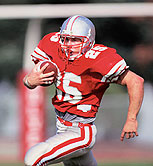- Double Mastectomy May Offer No Survival Benefit to Women With Breast Cancer
- Toxic Lead Found in Cinnamon Product, FDA Says
- Certain Abbott Blood Sugar Monitors May Give Incorrect Readings
- Athletes Can Expect High Ozone, Pollen Counts for Paris Olympics
- Fake Oxycontin Pills Widespread and Potentially Deadly: Report
- Shingles Vaccine Could Lower Dementia Risk
- Your Odds for Accidental Gun Death Rise Greatly in Certain States
- Kids From Poorer Families Less Likely to Survive Cancer
- Tough Workouts Won’t Trigger Cardiac Arrest in Folks With Long QT Syndrome
- At-Home Colon Cancer Test Can Save Lives
College Football Players Seem to Grow Bigger and Stronger, But Not Faster


THURSDAY, Sept. 12College football players may get bigger and stronger during their four-year careers, but apparently all those grueling drills don’t make them run faster or jump higher, new research finds.
“This longitudinal study shows you can make [players] bigger, leaner and stronger, but speed and power don’t change. You have to recruit speed and power,” said study author Bert Jacobson, a professor of health and human performance at Oklahoma State University.
“This advice is more geared for wide receivers, running backs, corners and safeties,” he noted. The findings appear in the September issue of the Journal of Strength and Conditioning Research.
The researchers followed 156 football players for seven years, including the four years of their college careers. All were from NCAA Division I colleges.
Ninety-two players were offensive or defensive lineman. The offensive lineman’s job is to move opposing players out of the way so that their team can move the ball forward. The defensive lineman’s job is to try block players from moving forward. Size and strength are crucial for these positions.
The remaining 64 were skill players, defined in the study as either wide receivers or defensive backs. These are the players who most need speed and power.
Power is the ability to jump vertically, according to Jacobson, a skill that comes in handy when a ball is passed too high or if you need to try to deflect a pass so the opposing team can’t catch it. Strength was measured with various weight-lifting challenges. Speed was assessed with a 40-yard sprint.
Players’ height and weight were also measured each year. At study’s start, linemen’s average weight was 283 pounds. Over the course of the study, they gained an average of roughly 3 percent of their original weight, with 292 pounds the average ending weight.
During that same time, they dropped their average body fat from 22.5 percent to 20.6 percent, meaning that although they were getting larger, they were gaining more muscle mass rather than more fat.
The linemen got significantly stronger over their college careers — with their ability to bench press increasing by 18 percent, from about 350 to 410 pounds. However, they actually lost a little bit of speed. Their power was virtually unchanged.
During their college careers, the skill players gained 9 percent over their original body weight, going from an average of 175 pounds to an average of 191 pounds. At the same time, their body fat dropped from a lean 8.4 percent to an even leaner 8.1 percent, according to the study.
As with the lineman, the skill players improved their strength dramatically. But, they also lost a little speed in the 40-yard sprint from year one to year four. They gained an average of almost 1.5 inches in their vertical jump from year one to year two, which was the only year that there was a statistically significant increase in power, according to the study.
Jacobson said the reason that speed and power don’t increase much over time is that these skills are dependent on the type of muscle fiber you have. He said people have either fast-twitch or slow-twitch muscle fibers, and “that’s not going to change. You’re born with that speed,” he said.
Dr. Victor Khabie, chief of sports medicine and chief of surgery at Northern Westchester Hospital in Mt. Kisco, N.Y., said he was surprised by some of the study’s findings. “I find it hard to believe that you can increase strength, but you can’t increase power,” he said.
“This study says some things are innate, like speed and power. So, you are who you are, and you can’t change natural talent,” Khabie said. “But, they didn’t measure quickness or reflex. In a play, if you get the first step and get the inside move on a defender, then you’re open for a play.”
In addition, Khabie said there’s more to speed and power than fast or slow muscle-fiber twitching. “Your hip, knee and ankle joints hold the muscles together and how those joints are coordinated in their movement affects your speed,” he said. “If someone has a smooth run, what it means is they have innate coordination that probably starts in the brain.”
Still, he said this was an important study that — if the findings are replicated — “could have ramifications on how we look at training.”
More information
Learn about football safety from the Nemours Foundation.
Source: HealthDay
Copyright © 2024 HealthDay. All rights reserved.










